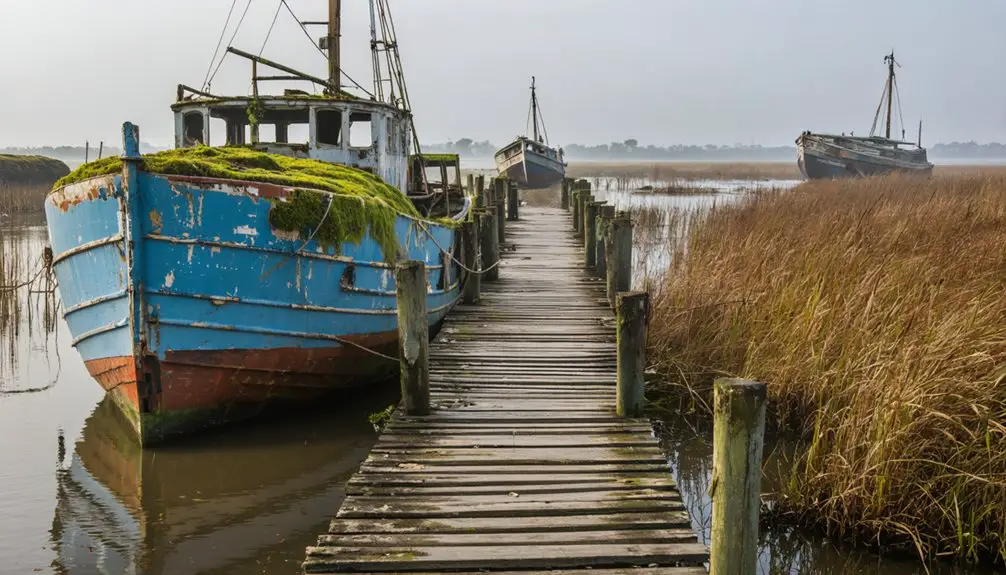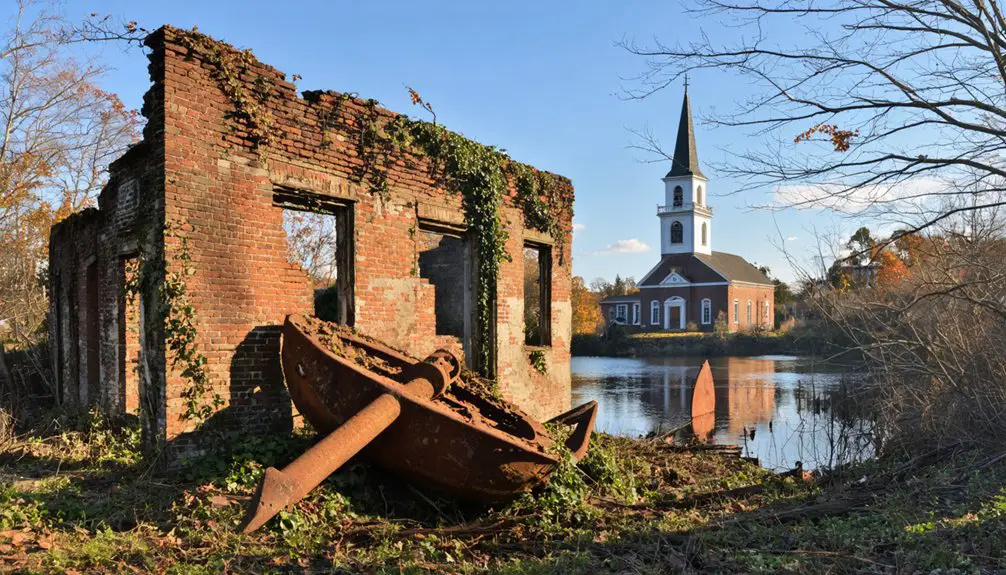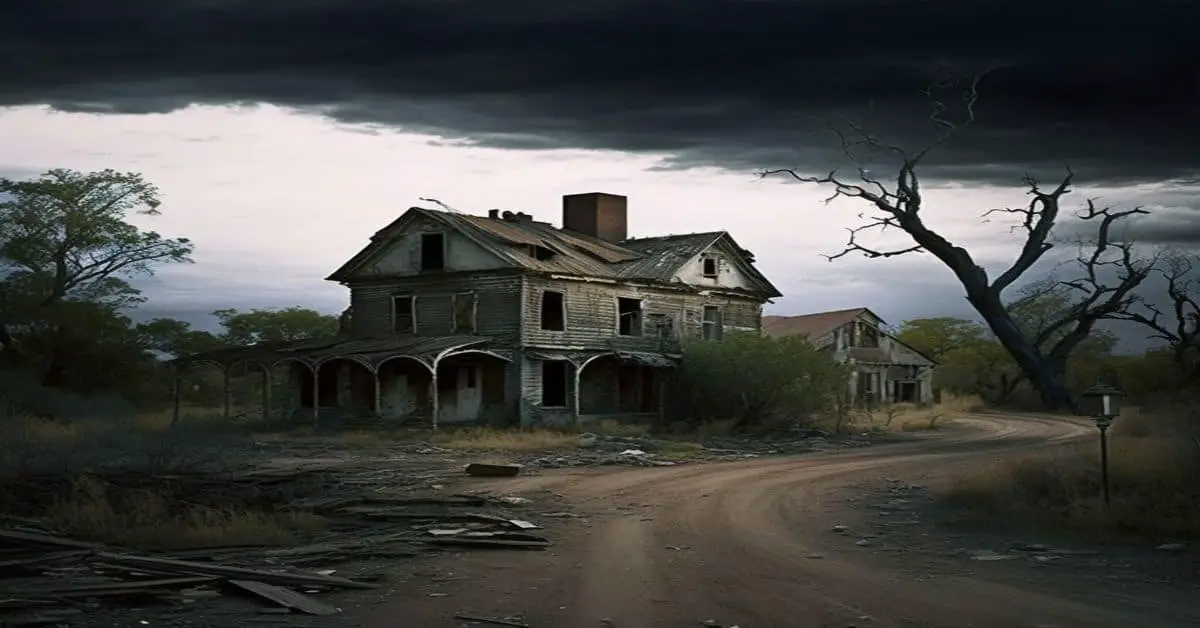You’ll find Broad Creek’s ghostly remains along Maryland’s Eastern Shore, where a thriving colonial trading post once connected Native American tribes with European settlers in the mid-1600s. The town grew around William Claiborne’s Kent Island operations, featuring a ferry landing, courthouse, jail, taverns, and the prominent Christ Church. Maritime commerce and packet boats kept the settlement bustling until its decline. This forgotten hub holds fascinating tales of the Chesapeake’s colonial maritime heritage.
Key Takeaways
- Broad Creek was established in 1706 as a colonial trading post but eventually declined, leaving only archaeological remnants of its infrastructure today.
- The once-thriving maritime hub featured a wooden palisade wall, courthouse, jail, tavern, and Anglican Christ Church during its peak.
- Historical artifacts and building foundations discovered through archaeological surveys reveal the ghost town’s former commercial significance.
- The abandoned settlement’s location along Chesapeake Bay served as a crucial ferry landing and steamboat service point until its decline.
- Digital preservation projects and archaeological studies now document Broad Creek’s transformation from bustling colonial port to ghost town.
The Rise of a Colonial Trading Post
Before becoming an official Maryland town in 1706, Broad Creek emerged as a strategic trading post where Native American tribes and European settlers exchanged goods in the mid-1600s.
You’ll find its origins traced to William Claiborne’s early trading operations on Kent Island in 1631, where European “truck” was traded for Native American furs and corn.
When Maryland’s “Act for the Advancement of Trade” established Broad Creek as a town, colonial commerce flourished at this prime location near the Potomac River.
The settlement’s trading practices expanded to include tobacco cultivation, shipbuilding, and global trade networks.
The Kent Island Heritage Society continues to preserve this history through educational programs and exhibits.
The town’s planned layout of 100 one-acre lots accommodated warehouses, a landing, and public buildings. The settlement later included a courthouse and church as it developed into a significant colonial center.
Life Along the Chesapeake Bay Ferry Line
As you’d find yourself at Broad Creek’s bustling ferry landing in colonial times, you’d witness an array of merchants trading goods, travelers seeking passage across the Bay, and sailors loading cargo onto vessels bound for Philadelphia and Annapolis.
The port’s tavern served as an essential gathering spot where you could meet fellow travelers, hear news from distant shores, and conduct business deals while waiting for favorable sailing conditions. These packet boats were known for their impeccable service and fine dining experiences during voyages.
You’d see how the ferry service transformed Broad Creek into a significant link between isolated Eastern Shore communities and major colonial centers, with daily operations bringing life and commerce to this strategic landing point. By 1919, the arrival of the Governor Emerson C. Harrington marked a new era as the first ferry designed specifically for motor vehicles.
Ferry Commerce and Trade
While sailing vessels once dominated Chesapeake Bay’s transportation, the introduction of ferry commerce at Broad Creek marked a significant shift in regional trade.
You’d have witnessed major ferry innovations in 1813 when Captain Edward Tripp launched scheduled steamboat service, replacing unreliable sailboats with predictable commerce across the bay.
Broad Creek’s ferry terminal became a bustling hub of economic integration, where you’d find courthouses, taverns, and churches supporting the community.
The ferry system connected Annapolis and Philadelphia, while linking Western Shore cities with Eastern Shore communities.
Individual entrepreneurs operated these early lines, creating diverse commercial opportunities.
You could transport everything from agricultural produce to seafood products, establishing essential trade routes that sustained Bay communities.
This network of water-based commerce transformed Kent Island’s economy throughout the 19th century.
These ferry services remained vital until the 1952 bridge revolutionized cross-bay transportation.
Due to the numerous locations sharing the name, travelers often consulted disambiguation pages to locate the correct Broad Creek ferry terminal.
Daily Life at Port
Once ferry service took hold at Broad Creek, daily life along the Chesapeake Bay ferry line became a vibrant blend of commerce and community.
You’d find yourself swept up in the ferry culture, where local taverns served as gathering spots for travelers, crew members, and residents alike. The daily rhythm of arriving and departing vessels structured life at the port, while courthouse and church activities anchored the community’s administrative and spiritual needs.
If you’d worked there, you might’ve been a ferry captain, deckhand, or one of the many support workers who kept the port running smoothly.
During summer months, you’d see increased activity as tourists flocked to the area. Local fishermen and watermen often supplemented their income with ferry-related work, creating a dynamic waterfront community where maritime trades intersected.
Connecting Colonial Communities
The Chesapeake Bay ferry line transformed Broad Creek into an essential link between colonial settlements, connecting Annapolis and Philadelphia from the 17th through 19th centuries. You’d find this significant hub of colonial transportation bustling with activity as ferries carried traders, travelers, and goods across the bay’s waters.
At the heart of Broad Creek’s grid-planned town, you’d discover warehouses, markets, and public spaces where cultural interactions flourished. The ferry landing served as more than just a transit point – it was where scattered colonial communities came together. Similar to how the Davis Coal & Coke founded model towns, Broad Creek was carefully planned with community facilities. The establishment of Broad Creek Chapel in 1771 provided a spiritual center for the growing settlement.
When you traveled these water highways, you’d encounter churches, schools, and gathering places that united isolated settlements. The infrastructure of bridges, mills, and stores around Broad Creek created a network that empowered colonial expansion and commerce throughout the Chesapeake region.
Native American Heritage and the Nanticoke People
You’ll discover that the Nanticoke people established essential settlements along the Chesapeake Bay‘s tributaries, creating trade networks that stretched from Labrador to the Mid-Atlantic region.
Their community at Broad Creek emerged as a significant 3,000-acre reservation in 1707, serving as a hub for seasonal migrations between inland hunting grounds and coastal fishing areas. The tribe’s economy centered around fishing and trapping activities that sustained their communities for generations.
First contact with Europeans occurred when Captain John Smith encountered the tribe in 1608, leading to the establishment of beaver pelt trading alliances.
Nanticoke Settlement Patterns
Across Maryland’s Eastern Shore, Nanticoke communities established intricate settlement patterns centered around seasonal villages and natural resources. You’d find their domed wigwams and longhouses strategically positioned on high ground near rivers and bays, allowing them to maximize their survival through fishing, Nanticoke agriculture, and hunting.
These settlements weren’t static – seasonal migration was essential to their way of life. In spring and summer, they’d farm corn and squash near fertile riverbanks, while winter meant moving inland for hunting. Their villages included sweat lodges and were sometimes protected by log fences.
However, European colonization disrupted these traditional patterns. The 1684 reservation at Chicacoan Creek and the 1707 Broad Creek settlement restricted their movement, fundamentally altering their time-tested seasonal cycles and subsistence strategies.
Early Tribal Trade Routes
While Nanticoke settlements anchored their communities, intricate trade networks shaped their economic and social connections throughout the Eastern Shore.
You’ll find their trade routes followed the region’s waterways, with the Nanticoke River, Broad Creek, and Marshyhope Creek serving as essential corridors for commerce and seasonal migration.
The Nanticoke trade system connected various settlements across Delaware and Maryland, enabling exchanges of furs, crops, and crafted items.
They’d travel between fishing, farming, and hunting grounds following seasonal patterns, maintaining relationships with neighboring tribes like the Choptank and Delaware peoples.
Trading posts such as Handsell on Broad Creek became significant hubs where you’d see interactions between Native Americans and European settlers, though increasing colonial presence eventually disrupted these traditional trade networks and routes.
Forced Migration Legacy
Beginning in 1642, the Nanticoke people faced mounting pressure from Maryland settlers that fundamentally altered their way of life along the Eastern Shore.
Despite establishing a 3,000-acre reservation at Broad Creek by 1707, colonial restrictions disrupted traditional migratory patterns and forced the tribe into sedentary living.
- You’ll find that colonial policies required Nanticoke people to petition authorities just to leave their reservation for seasonal hunting.
- By the mid-18th century, many Nanticoke were forced to migrate northward to New York and westward to Ohio and Indiana.
- Some groups established new communities near Delaware’s Indian River, showing cultural resilience through institutions like the Nanticoke Indian Museum.
- Though displacement fragmented the population across several states, organized groups like the Nanticoke Indian Association helped preserve tribal identity.
Town Planning and Early Infrastructure
As Broad Creek emerged in the mid-1600s on western Kent Island, Maryland, the settlement quickly developed crucial colonial infrastructure to support its growing community.
You’d find a well-planned urban layout protected by a wooden palisade wall built in 1634, anchored by key facilities that served the town’s 120-plus English settlers. The infrastructure evolution centered around a ferry landing that connected Broad Creek to other Chesapeake Bay destinations, while a courthouse, jail, and tavern formed the administrative core.
You’d also see the Anglican Christ Church, which became a significant religious and social hub. Early industrial development included a grist mill and trading station, supporting the settlement’s agricultural economy focused on tobacco farming and livestock.
Maritime Commerce and Transportation Hub

During its colonial heyday, Broad Creek’s strategic location on a narrow stretch of the Potomac River established it as an essential maritime hub connecting Maryland and Virginia.
The creek’s estuarine environment supported vibrant trade dynamics, with schooners maneuvering its waters to transport goods and raw materials throughout the Chesapeake Bay region.
Schooners glided through Broad Creek’s tidal waters, carrying the lifeblood of colonial commerce across the Chesapeake Bay.
- Ferry innovations included accommodations for both travelers and horses, providing crucial crossings between Maryland and Virginia.
- Multiple licensed taverns served as bustling centers for merchants, planters, and ship captains.
- Local shipwright Humphrey Batts operated repair services, supporting maritime commerce.
- The port collected taxes and fees, reflecting its economic significance.
The advent of steamboats and railroads in the 19th century gradually shifted commerce away from Broad Creek, though its legacy as an early colonial port endures.
Religious and Community Development
While Broad Creek flourished as a maritime hub, its religious and community foundations took shape through careful town planning that allocated 100 one-acre lots with dedicated spaces for churches, chapels, and public gathering areas.
Christ Church served as the main congregation, though it later relocated to Stevensville in 1880. You’ll find evidence of diverse religious gatherings throughout the town’s history, from the African American community‘s camp meetings at Old Forge to the Nanticoke tribe‘s presence near Broad Creek.
The town maintained strong community identity through public buildings, market houses, and organized governance, complete with stocks and whipping posts by 1716.
Unfortunately, as the population shifted to Stevensville in the mid-19th century, Broad Creek’s religious significance began to decline.
The Shift of Power to Stevensville

The mid-19th century marked a dramatic shift in Kent Island’s power dynamics when Broad Creek lost its prominence to the emerging town of Stevensville.
As historical landmarks like Christ Church relocated and economic decline set in, you’ll find that Broad Creek’s influence diminished rapidly. The transformation was driven by technological changes, particularly steamboat travel and railroads, which favored Stevensville’s location.
The rise of steamboats and railroads sealed Broad Creek’s fate, shifting power to Stevensville’s more strategically positioned settlement.
- Steamboat routes redirected commercial activity away from Broad Creek by the 1850s
- Businesses and infrastructure moved to Stevensville through the 1860s-70s
- Christ Church’s relocation in 1880 symbolized the complete transfer of power
- By the late 19th century, Stevensville had emerged as Kent Island’s administrative, commercial, and transportation hub
The shift wasn’t just about location – it represented a fundamental change in how Kent Island’s communities connected to the wider world.
Environmental Impact on Settlement Patterns
Natural features played a decisive role in shaping Broad Creek’s settlement patterns from colonial times through its decline.
You’ll find that its prime location along the Potomac River, combined with two tributaries and fertile soils, initially attracted diverse cultural groups and fostered settlement dynamics that supported agriculture and trade.
However, environmental challenges gradually undermined the town’s ecological sustainability.
Water quality issues, including potential mine contamination and poor wastewater treatment, stressed the community. The decline of natural resources, particularly timber and arable land, weakened the local economy.
While conservation efforts through the Conservancy of Broad Creek have protected 72 acres of land, these measures came too late to prevent the town’s abandonment.
Today, forest stewardship plans and conservation easements maintain the area’s rural character while limiting development.
Preserving Broad Creek’s Historical Legacy

Preserving Broad Creek’s historical legacy has centered on extensive restoration efforts of its two primary surviving landmarks – the historic cemetery and Christ Church.
Through dedicated community engagement, local historical societies and preservation groups work tirelessly to maintain these structures while documenting the town’s rich history.
You’ll find these key preservation initiatives in action:
- Historical markers and informational signage placed throughout the site to educate visitors about the town’s regional significance
- Public history programs and lectures conducted by historical societies to increase local awareness
- Archaeological surveys revealing remnants of early settlements, including warehouses and mills
- Digital preservation projects making historical records, maps, and artifacts accessible to researchers and the public
The collaborative efforts between historians, archaeologists, and residents guarantee Broad Creek’s story endures for future generations.
Frequently Asked Questions
What Was the Average Property Value of Lots in Broad Creek?
You can’t determine the exact historical valuation, as property market records aren’t documented. Lots likely ranged from minimal value to abandonment, following typical ghost town patterns in Maryland’s declining areas.
Were There Any Documented Crimes or Notable Court Cases in Broad Creek?
While you’ll find evidence of a courthouse and jail in Broad Creek’s infrastructure, there aren’t any documented crime statistics or notable incidents preserved in readily available historical records.
What Types of Goods Were Primarily Traded Through Broad Creek’s Warehouses?
You’d find tobacco dominating the trade dynamics, with local planters bringing crops for inspection before export. The warehouses also handled agricultural goods and imported British merchandise, creating significant economic impact.
How Many Families Lived in Broad Creek During Its Peak Population?
You’ll find population dynamics suggest 30-100 families lived there at peak, though exact family structures aren’t documented. This estimate comes from comparing typical colonial town sizes and ferry-based commerce patterns.
Did Any Famous Historical Figures Visit or Stay in Broad Creek?
Beyond William Claiborne’s documented presence in 1631, you won’t find clear records of famous visitors in Broad Creek, though its historical significance as a ferry terminus likely attracted notable colonial officials.
References
- https://www.mncppcapps.org/planning/publications/pdfs/68/Broad Creek History.pdf
- http://allenbrowne.blogspot.com/2012/03/upper-potomac-ghost-town-in-southwest.html
- https://peninsularoots.wordpress.com/2020/02/09/broad-creek-bridge-and-the-old-forge/
- https://peninsularoots.wordpress.com/2014/03/09/sockum-and-the-nanticokes-of-broad-creek/
- https://en.wikipedia.org/wiki/Broad_Creek
- https://npshistory.com/publications/haha/history.pdf
- https://kentislandheritagesociety.org/kent-island-history/
- https://centrevillespy.org/kent-island-has-its-day-by-brent-lewis/
- https://www.pghistory.org/PG/PG300/tobacounty.html
- https://easternshorebrent.com/2016/12/13/the-chesapeake-bay-ferries-1919-1952/



